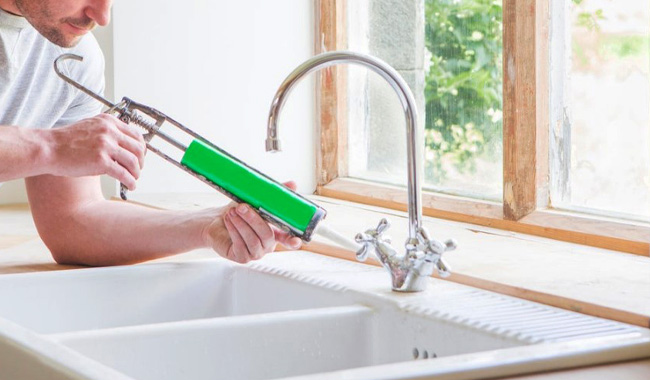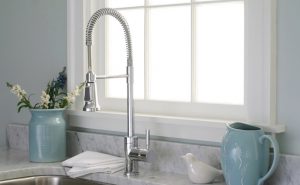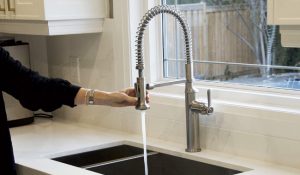Have you turned off your kitchen faucet, but still, the water continues to flow?
When your faucet doesn’t turn off, you may see two types of scenarios, either the water is slowly dripping, or it is flowing rapidly. Though it’s not going to end this world, the sound may seem annoying.
Hold on; the great news is that fixing a leaky faucet is an inexpensive and easy task. All you’ll need are a few tools and some spare components.
Well, this discussion will guide you on how you can repair a leaky faucet on your own.
Reasons Behind Your Faucet Won't Turn Off
Most of the time, your faucet won’t turn off because there is a problem inside your faucet handle due to continuous usage for a long time. It may be a component inside your faucet’s handle that got damaged.
So, let’s dive into all the possible reasons behind your faucet is not turning off:
Stripped Handle
As per your faucet, the cartridge is attached to the washer on the handle, and the two parts operate alongside to control the flow of water.
When the washer on your handle’s stem becomes stripped, it will feel loose or spin on the end and causes a running faucet.
Broken Cartridge
The cartridge might rust owing to silt accumulation in the water. So, it may not function appropriately and results in a running faucet in the long run.
Old Handle’s Seat
If you are using your faucet for an extended period, and if the valve seat is worn out, then it also can cause a leak.
Water Pressure
If your faucet leaks only at specific periods of the day, then it may be the water flows at high pressure and causes the leak.
How to Fix The Faucet That Won’t Turn Off-
To fix your problematic faucet on your own, follow the steps below carefully:
First, Identify the Type of Your Faucet and Handle:
In the first step, you will have to identify what type of faucet you have and which kind of handle it contains because this knowledge will help you with the removal and resetting process.
You can either get the details of your faucet and its handle from the user manual or search the model online to see the details.
Get Ready with the Required Tools:
Now let’s imagine that your faucet is leaking because of the above reason, and fixing this, you’ll have to have the following tools with you:
Required Tools:
- A Pipe Wrench
- A Set of Small Allen Wrench
- A flat head screwdriver
- A Needle-Nose Pliers
You may also like- Ceramic Vs. Fireclay Sink
Now Begin the Fix:
Once you have identified the types of your faucet and its handle, and you also got the tools with you, that means now you are ready to fix your problematic faucet.
Please follow the steps below carefully to fix this on your own:
Step 1: Shutt the Water Supply
At first, you have to turn off the water supply to your sink. Usually, you will find the water shut-off valve beneath the sink, and if you are dealing with your bathtub, you may need to turn off the main water supply of your home.
After that, ensure you have covered the drain to prevent any component from passing through it.
Step 2: Disassemble your Faucet
Start removing the faucet handle using the pipe wrench once you’ve properly turned off the water supply. But if you see a cover plate with a screw, use a flathead screwdriver or an Allen wrench to unscrew the cover and revolve the handle from your faucet.
After removing the locking nut, you must remove the faucet cartridge carefully and save it in a secure place.
Step 3: Now, Identify the Problem and Get Your Spare Parts
After removing these two sections, you will have to check the rubber washers, O-rings, and other components and see if they got rusted or worn out.
Any rusted or worn-out components may be the root cause of your leak, and they must be replaced.
Once you have identified the problematic component, you have to buy a new part and replace it carefully.
Step 4: Reassemble the Faucet
Once you’ve replaced the problematic component, now, you have to replace the cartridge. After this, repeat the removal processes in a reverse manner and make your faucet operational again.
Pro Tips:
To prevent any unwanted hassle, please do some study on your sink to figure out how to detach the cartridge- you may find the information online or in the manual for your sink. Other Related Articles for You:When Do you need Plumber’s Help?

If you follow all the steps above but still the water is running when the faucet is off, that means there is some other problem on your faucet.
It might be that some more components have been damaged, or the entire faucet set needs to be replaced with a new one because of a long usage period.
In that case, it is better to call a plumber who can help you out.

Delta Faucet 9178T-AR-DST Kitchen Sink Faucet Review
Whenever you are thinking about installing a new faucet or replacing the old one then you might need some proper idea about the faucet you

How to Choose a Kitchen Faucet
In any home, the kitchen is the command center. This is where you will prepare meals, chat about the day with your loved ones, clean

Best Kitchen Faucets Reviews with Buying Guide
Perhaps the most used item in a kitchen, other than the stove, is the faucet. On average a day, a person may use the tap

Moen Vs Delta Kitchen Faucet – Head to Head Comparison
When it comes to faucets, there is no doubt that Moen and Delta faucets are at the top of the game. But which one is

Is It Worth Buying an Expensive Kitchen Faucet?
When you are shopping for a new kitchen faucet, you may come across some pricey options that range between $500 and $1,000, or even more.

Best Pull Down Kitchen Faucets : Top 9 Picks for 2023
The sophisticated design of the pull-down kitchen faucets does complement your kitchen’s décor. It’s durable and lasts longer. Besides, it offers superior spray stream or


